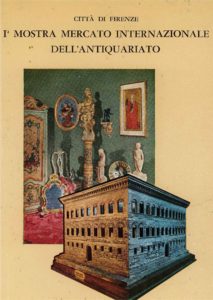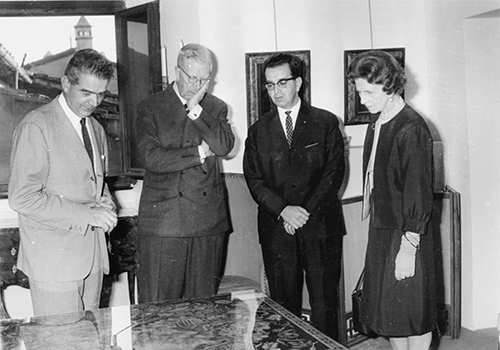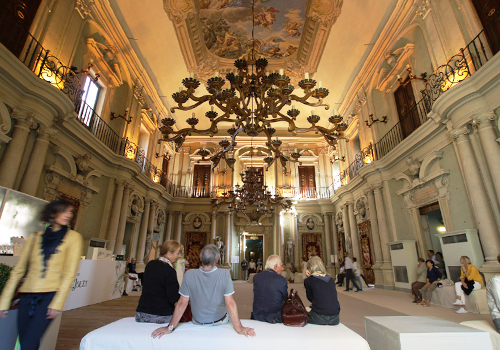history
BEGINNINGS

In 1953 , in a historical context marked by strong economic and creative development such as that of the 1950s, Luigi Bellini had the enlightened intuition of gathering the best of Italian antiques in Florence.
Six years later (1959), his sons Mario and Giuseppe, assisted by the members of the Associazione Antiquari d’Italia (specially incorporated during the same year), gave birth to the most important Italian antiquarian event and one of the most significant in the world. It saw the involvement not only of Italian antique dealers, but also of an elite echelon of foreigners, who perceived in Florence the sense and image of the humanist culture, understood as a refined and passionate renewal of ethical, aesthetic and spiritual values.
The historic Palazzo Strozzi hosted the Fair, a building steeped in history, renowned worldwide, and an excellent example of the Italian Renaissance, which became an icon and international reverberation of the same event.
Chairman of the Executive Committee at the first edition of the 1959 exhibition was Giacomo Devoto, glottologist, philologist and literary critic, who emphasized the dual aspects that the exhibition would have highlighted: the first, dissemination and awareness of ancient Italian art, understood not only as painting and sculpture, but also as furniture and furnishings ; and the second, purely commercial, which saw the antiques segment as an integral part of the country’s economic development between the fifties and seventies.
The Executive Committee included much loved Piero Bargellini, the man who during the most disastrous days of the 1966 Florence flood demonstrated to the citizens that he was a figure of the highest ethical and moral profile, in addition to one of the most authoritative and refined exponents of the Italian, but above all foreign, antiques market.
The success was immediate and overwhelming, so much so that police intervention was necessary to discipline the enthusiastic crowd, which during that month of opening to the public had taken the Fair by storm. An exceptional visitor, who arrived in Florence in an unofficial capacity the day before the event closed, was the President of the Italian Republic, Giovanni Gronchi.
This all took place before the Autostrada del Sole (motorway between Milan and Naples) was built, when the transportation of artworks was still inexistent and instead simply relied on furniture removal companies, and when the very concept of communication was entrusted to refined articles published in the legendary cultural section on the ‘third pages’ of the main newspapers.
THE TWENTIETH CENTURY

In 1961, the exhibition was inaugurated by the then mayor Giorgio La Pira and was animated by the vivacious and spontaneous participation of the President of the Council of Ministers Amintore Fanfani. The chairmanship of the Executive Committee passed over to Prince Giovanni Ginori Conti.
This edition was also a showcase of the world of entertainment and cinema, with appearances by such celebrities as the bubbly Josephine Baker, the divine Greta Garbo, explosive Sofia Loren, American director and actor John Huston, proud Silvana Mangano accompanied by Mauro Bolognini, and graceful Paulette Goddard with Erich Maria Remarque, testimonies of that sophisticated world of jet-setters.
The most significant fact of the Mostra dell’Antiquariato di Firenze was that it substantially changed the perception of the antiquarian from a mere discoverer of antiques to a refined connoisseur of the forms and colours that art had assumed over time.
A generation of young art historians grew up during those years, devoted to the systematic and widespread study of the various sectors of antiques aimed at historical and documentary enhancement, and the prevailing taste was strictly oriented towards the late Renaissance, the Venetian eighteenth century and French furnishings of the eighteenth century.
The success of the event spread to the entire urban fabric, with historical re-enactments that attracted a crowd of onlookers, as well as worldly events with a sumptuous character. The exposure over the years became a must, no longer targeting merely a small circle of experts and collectors, but also a nascent and prosperous bourgeoisie that had established itself with the economic boom.
The flood of November 4, 1966 was an unparalleled catastrophe for the Florentine antique dealers, but despite this, the following year the exhibition opened again regularly, thanks to the effort and work of the entire city under the guidance of Mayor Piero Bargellini.
From 1959 to 1975, this event was hosted in Palazzo Strozzi in the historic centre of Florence. In 1977 the Biennale was forced to move to Palazzo Giuntini, due to the inaccessibility of the previous location, where it returned two years later and remained until 1993. Meanwhile, in 1986, Guido Bartolozzi took over from the Bellini brothers as General Secretary and the Fair took on the permanent name of Biennale Mostra Mercato Internazionale dell’Antiquariato. In 1995, the Biennale moved to Palazzo degli Affari designed by Pier Luigi Spadolini, before transferring to Palazzo Corsini sull’Arno in 1997, this time permanently.
THE TWENTY-FIRST CENTURY

In 2011, Giovanni Pratesi was elected General Secretary, and driven by a great desire for renewal he called on Pier Luigi Pizzi, undisputed director, set designer and costume designer, to create a mise-en-scène aimed at enhancing the exhibition spaces.
Another element that Pratesi tackled with resolute determination already during the first year of his tenure was the possibility for antiquarians and collectors to liberate the works of art from any legislative constraints. Thanks also to the collaboration of the then Superintendent Antonio Paolucci, the conditions were created for equipping each work, even before the start of the event, with a certificate of free circulation, issued by the Florence Export Office and the Ministry and Cultural Activities. This was an exclusive feature of the Biennale that marked an attitude of mutual respect and shared will in the promotion and conservation of the works of art.
Another element emphasising the profitable relationship between the institutions and the antiquarian world was the decision to confer the chairmanship of the Scientific Committee on the Superintendent of the Polo Museale Fiorentino, as well as the formation of a high-profile vetting conducted by renowned art historians, called upon to evaluate the golden rules that have always governed the antiques market: certainty of quality, origin, state of preservation and – above all – the authenticity of the artworks, a prime value for a market targeting excellence. Indisputable requirements that determine a natural selection of exhibitors, able to fully satisfy the pre-eminence of any art object presented. Lastly, the Carabinieri Department for the Supervision of the Artistic Heritage guaranteed the correct titles of origin.
Today the Biennale is considered the most important Fair the world for ancient Italian art, and every two years it brings to Florence the crème de la crème of national and international antiques by inviting a select group of antique dealers capable of proposing an important and very varied choice of works, guaranteed by an authoritative vetting.
A significant sequence of official appointments accompanies the exhibition. The Gala Dinner is the event most looked forward to by guests from numerous EU countries and the USA as it offers the chance to visit the exhibition in an absolute preview and immediately afterwards, to enjoy an elegant and refined dinner topped off by a fireworks display.
A customary feature of the event, small but significant temporary exhibitions of an informative nature are held inside Palazzo Corsini, and in recent years they have exhibited valuable and evocative objects from public and private collections, such as the prizes awarded for the most important works presented by the exhibitors and to personalities acclaimed for their high cultural value.

